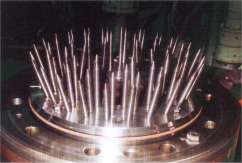|

|
Operational Information
The Two Stroke
Crosshead Engine
The Piston
|
****JavaScript based drop down DHTML menu generated by NavStudio. (OpenCube Inc. - http://www.opencube.com)****
|
|
|
The Piston comprises of two pieces; the
crown and the skirt. The crown is subject to the high temperatures
in the combustion space and the surface is liable to be
eroded/burnt away. For this reason the material from which the
crown is made must be able to
maintain its strength and resist corrosion at high temperatures.
Steel, alloyed with chromium and molybdenum is used, and some
pistons have a special alloy welded onto the hottest part of the
crown to try and reduce the erosion caused by the burning fuel.
The crown also carries the 4 or 5 piston ring grooves which may be
chrome plated.
The cast iron skirt acts as a guide within the cylinder liner.
It is only a short skirt on engines with an exhaust valve (known
as uniflow scavenged engines), as unlike a trunk piston engine, no
side thrust is transmitted to the liner (that's the job of the
crosshead guides).
A forged steel piston rod is bolted to the underside of the
piston. The other end of the piston rod is attached to the
crosshead pin.
Pistons are cooled either using water or the crankcase oil.
Water has a better cooling effect than oil, but there is a risk of
leakage of water into the crankcase.
|
 |
|
Modern engines have oil cooled pistons. The piston
rod is utilised to carry the oil to and from the piston. The rod
is hollow, and has a tube running up its centre. This gives an
annular space which, with the central bore, allows a supply and
return. The MAN B&W piston has an 8mm thick heat resisting layer
of a hard nickel-chrome alloy called Inconel welded to the hottest
part of the crown to resist the "burning" of the piston crown. |
 |
 |
An alternative method of cooling uses a nozzle
plate and nozzles. Note that the oil goes up the annular space
formed between the oil tube and the bore in the piston rod, and
returns down the centre.
The oil is sprayed up matching bores onto the underside of
the crown. This allows the crown to be made as thin as possible,
to allow for maximum heat transfer while maintaining strength,
and combined with the "cocktail" shaker effect caused
by the reciprocating motion, gives efficient cooling. |

This Photo Shows the Nozzle Plate and
Nozzles |

This Photo Shows the Underside of the
Piston Crown |
|
When
overhauling the piston it is important to check the thinning of
the piston crown due to burning/erosion/corrosion. The piston
should be dismantled to check the cooling space. If this is
subject to a build up of carbon (in an oil cooled piston) or
scale (in the case of a water cooled piston) then this may have
led to thermal stressing of the piston, which in its turn can
lead to cracking of the piston crown. If the cooling oil is
allowed to leak into the combustion space then the consequences
could be disastrous. |
 |
PISTON RINGS
The Piston Rings are made of alloying cast iron with chromium,
molybdenum, vanadium, titanium, nickel and copper. They are harder than
the cylinder liner in which they run to give them a maximum life.
Piston rings seal the gas space by expanding outwards
due to the gas pressure acting behind them. They also spread the
lubricating oil up and down the cylinder liner and transfer heat to the
liner walls.
When overhauling the piston it is important to check
the ring grooves for wear and the piston ring condition. The axial and
butt clearances should be measured and recorded.
More details
on the manufacture of piston rings can be found in the
members section




|






